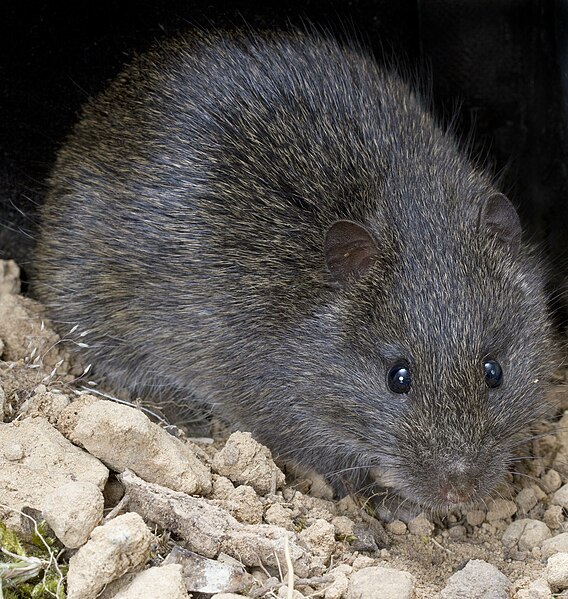Nature has given all animals the physical assets they need to survive in their habitat. In this case, “good eyesight” is a subjective expression. While rats lack the razor-sharp vision of a bird of prey, their vision is more than adequate for the tasks they must complete on a daily basis. However, does this mean a rat’s eyesight is good? Let’s take a further look!
Do Rats Have Good Vision?
It is worth emphasizing that rats are not like other animals in that they do not have a true 20/20 vision, to begin with. In fact, if you looked through the eyes of a rat, you would see that they perceive the world through a blurry haze.
They can only see a few feet at best and are relatively nearsighted critters, so if your pet rat is not reacting to your presence across a large room, it is because they cannot see you. This doesn’t indicate they are losing their vision; it just was not that good to begin with.
Rats, on the other hand, have much better hearing. If you open a door, cough, or scuff your shoes on the floor, they will react.
The truth is that rats adapted to living and feeding in low light conditions; their vision is poor even close up, and it is non-existent at a longer distance. Therefore, before you start worrying about your rat turning blind, keep in mind that your rat is not very reliant on its vision in the first place.

Can Rats See in Color?
Yes, rats can see things in color. In their retina, they contain two kinds of color cones: one for seeing blue ultraviolet light and the other for recognizing green light or colors. Rats have a similar color perception to human beings, except they are red-green colorblind, which means they see shades of red as a generally dark tone. In terms of vision, rats come up short of people in terms of clarity.

Rats Can See Ultraviolet Light
Rats (Rattus norvegicus) have two types of cones, one with an ultraviolet-sensitive photopigment (UV) and the other with a pigment that is most sensitive in the visible spectrum’s middle wavelengths. Via recordings of behavioral discrimination tests and a gross electrical potential (the electroretinogram, ERG), the researchers looked at how signals from these two cone types influence rat vision. The spectral sensitivity functions acquired from both methods of measurements show that each of the cone classes has a distinct contribution.
However, the behavioral index shows a significant increase in relative sensitivity to UV light; for example, rats are roughly equally sensitive to middle-wavelength and UV lights under particular photopic test circumstances. The thresholds for UV and middle wavelength lights were shown to be differentially enhanced in the presence of chromatic adapting backdrops in adaptation tests. This suggests that the rat visual system may utilize signals from the two cones to facilitate color discriminations. After that, wavelength discrimination studies done on rats revealed that they have a dichromatic color vision.

Rats Have Blurry Vision
Due to the number and size of light-detecting cones in a rat’s eyes, they can distinguish distinct colors but see much of their surroundings as a blur. A rat’s capacity to sense color contrast is limited, but given that they are predominantly nocturnal, this isn’t a critical adaption for them. Moreover, rats’ eyes have a great reaction to brightness and are often light averse.
Poor Visual Acuity
The rat’s world is a hazy one. The number of lines that may be seen as distinct inside a degree of the visual field is assessed in cycles per degree (cpd), which is a measurement of visual acuity. Human acuity is around 30 cpd, one cpd for normally pigmented rats, and 0.5 for albino rats (Prusky et al. 2002, 2000; also see Birch and Jacobs 1979 who found 1.2 cycles per degree for pigmented rats and 0.34-0.43 cycles per degree for albino rats). When we convert Prusky’s cpd measurements to vision chart measures, we find that a typically pigmented rat has 20/600 vision; however, an albino rat has 20/1200 vision.
The density of ganglion cells in a rat’s retina can also be used to determine rat acuity. The higher the acuity at that location of their retina, the denser the ganglion cells will cluster. Thus, the densest area of ganglion cells in a rat is 52.8o broad and placed slightly temporal to and above the optic disk (defined as the zone covering 75 percent of maximum ganglion cell density). This area has a maximum density of 6,774 cells/mm2. This is not extremely dense; the fovea, the densest part of a human’s retina, has a maximum of 38,000 cells per mm2 (Curcio and Allen 1990).
Rats Can Move Their Eyes Independently
Each of a rat’s eyes may move independently. The eyes of a rat are on the side of their head, allowing them to see with a panoramic perspective. Furthermore, rats have a blind spot in the middle of their optical field, just like humans. The brains of both humans and rats compensate for this by putting together the data from each eye and filling in the gaps. Rats, on the other hand, can broaden their field of vision in ways that humans cannot by shifting each eye in varying directions, allowing them to keep one eye on the skies. This is most certainly an evolutionary adaption that allows rats to be aware of dangers from predators in the air.
Rats Are Nearsighted
Unless an animal has extraordinarily big eyes, such as a bird of prey, or numerous eyes, it usually has to give up either depth perception or field of vision. Animals with eyes on the side of their heads have a nearly 180-degree perceptual range, but poor depth perception. People and other animals with front-facing eyes have great binocular vision and thus high depth perception, but a narrower range of perception. Rats, on the other hand, use a method called motion parallax to compensate for their weak depth perception. They can take several mental photos of the range of vision directly in front of them by bouncing their heads up and down. These head movements allow the brain to subsequently calculate an estimated depth.
Visual Orientation
Rats use visual signals from afar to orient themselves (Hebb 1938, Lashley 1938). Carr (1913) discovered that rats conditioned in a sideless maze lost their way if the circuit was rotated; however, their performances did not suffer if the visual environment was turned along with the maze (Higginson 1930). The inclusion of visual cues in mazes accelerates maze learning, whereas the absence of visual cues allows even the most experienced rat to make mistakes (Honzik 1936).
In addition, rats may rely on their whiskers rather than their sight at short distances. Rats were positioned on a sheet of glass in another experiment. The glass-covered half of a surface and the other half of a void. A visual cliff experiment is what it’s called. Human children, for example, prefer to step on the glass above the platforms rather than the glass over the dropoff because they rely on visual information to perceive depth. Rats, on the other hand, strolled boldly on the glass poised over a dropoff, choosing the shallow and deep sides of the glass in equal proportions.
Their whiskers indicated that they could walk on the solid surface. Rats with clipped whiskers, on the other contrary, avoided the dropoff and picked the shallow side, showing that they were forced to depend on vision to sense depth without whiskers (Schiffman et al. 1970).

They Rely on Their Other Senses
Pigmented rats rely on their senses of hearing and smell more than humans do. They rely heavily on whisker contact to navigate. When it comes to a rat, poor vision is not as severe as it is for a person. Rats live in an intense world of smell, sound, and touch, which allows them to navigate their environment effectively.
The albino rat has to compensate for its near-blindness by relying on its other senses. Unfortunately, when comparing pigmented and albino rats, albino rats seem to have a poor sense of smell. Albinos, on the other hand, seem to have adequate hearing.
Vision Damage
The rat’s retina loses most of its cells as it ages, and sections of the retina become larger and thicker. The capillaries that nourish the retina also thicken significantly (Weisse 1995). As a result, adult rats are unlikely to see as well as young rats.
Conclusion
Rats with normal pigmentation have hazy or poor vision with dim blues, greens, and ultraviolets. The rats may or may not understand the significance of these colors. This type of vision is presumably fine for rats, who can see food and other rats from a short distance yet are alert to approaching dogs or hawks, as well as distant orientation cues.
Within a few weeks of opening their eyes, albino rats are likely to be severely visually impaired or blind. Their retinas degrade, their brains struggle to coordinate images from their two eyes, and they have problems seeing in both strong and dim light.
Originally published on https://aaacwildliferemoval.com/blog/rats/rat-eyesight




